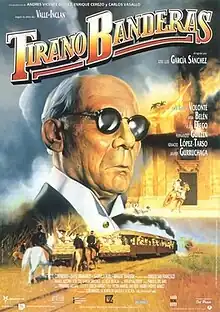| Banderas, the Tyrant | |
|---|---|
 Theatrical release poster | |
| Spanish | Tirano Banderas |
| Directed by | José Luis García Sánchez |
| Written by |
|
| Based on | Tirano Banderas by Ramón María del Valle-Inclán |
| Starring |
|
| Cinematography | Fernando Arribas |
| Edited by | Pablo del Amo |
| Music by | Emilio Kauderer |
Production companies |
|
Release dates |
|
| Countries |
|
| Language | Spanish |
Banderas, the Tyrant (Spanish: Tirano Banderas) is a 1993 internationally co-produced film directed by José Luis García Sánchez. It is an adaptation of the 1926 novel Tirano Banderas by Ramón María del Valle-Inclán. It was produced by companies from Spain, Cuba and Mexico. It stars Gian Maria Volonté as the title character, also featuring Ana Belén, Juan Diego, Fernando Guillén, Ignacio López Tarso and Javier Gurruchaga.
Plot
An adaptation of the (often presented as "unadaptable") novel Tirano Banderas, a standout work of the esperpento genre which underpins a criticism of abuses of power,[1] the plot tracks the developments in the fictitious republic of Santa Fe de Tierra Firme, ruled by megalomaniac dictator Santos Banderas.[2] The dictator has been noted to display an amalgamation of features from real dictators such as Rafael Leónidas Trujillo, Miguel Primo de Rivera or Juan Vicente Gómez.[3]
Cast
- Gian Maria Volonté as Santos Banderas.
- Ana Belén as Lupita la romántica.
- Juan Diego as Nacho Veguillas.
- Fernando Guillén as Quintín Pereda.
- Ignacio López Tarso as Domiciano de la Gándara.
- Javier Gurruchaga as Barón de Benicarlés.
- Patricio Contreras as Zacarías.
- Enrique San Francisco as Doctor Polaco.
- Gabriela Roel as Chinita.
- Manuel Bandera as Currito Mi Alma.
- Daisy Granados as Doña Rosita Pintado.
- Omar Valdés as Roque Cepeda.
- Gillian Vargas as Manolita.
- Patricio Wood as Filomeno Cuevas.
- María Galiana as Cucarachita la taracena.
- Samuel Claxton as Don Cruz.
Production
Featuring an ambitious budget of 450 million ₧,[4] the film was produced by Ion Films S. A. with the collaboration of Iberoamericana Films Producción S. A., Atrium Productions S. A., Promociones Audiovisuales Reunidas S. A., Antena 3 Televisión, ICAIC and Cinematográfica del Prado.[5]
It was shot in 1993 in Mexico and Cuba (Havana and Trinidad).[4]
Release
The 50th Venice International Film Festival ruled out the film for its official competition.[6] It screened as the only Spanish film in competition at the Valladolid International Film Festival (Seminci) in October 1993, where it met polarizing opinions.[7][8] The film had a limited theatrical release in Galicia before the end of the year just so it could become eligible for the 8th Goya Awards,[9] where it won the award for Best Adapted Screenplay and 5 additional awards in technical categories.[10] It had a wide theatrical release in Spain on 14 January 1994.[5]
Awards and nominations
| Year | Award | Category | Nominee(s) | Result | Ref. |
|---|---|---|---|---|---|
| 1993 | 38th Valladolid Film Festival | Best Actor | Gian Maria Volonté | Won | [8] |
| 1994 | 8th Goya Awards | Best Adapted Screenplay | José Luis García Sánchez, Rafael Azcona | Won | [11] |
| Best Supporting Actor | Javier Gurruchaga | Nominated | |||
| Best Editing | Pablo del Amo | Won | |||
| Best Art Direction | Félix Murcia | Won | |||
| Best Production Supervision | José Luis García Arrojo | Won | |||
| Best Costume Design | Andrea D'Odorico | Won | |||
| Best Makeup and Hairstyles | Magdalena Álvarez, Solange Aumaitre | Won |
See also
References
- Citations
- ↑ Barrientos Bueno 2012, pp. 49, 55.
- ↑ Barrientos Bueno 2012, pp. 57, 58.
- ↑ Fernández Santos, Ángel (30 October 1993). "Palabras como navajas". El País.
- 1 2 Barrientos Bueno 2012, p. 53.
- 1 2 Barrientos Bueno 2012, p. 61.
- ↑ "El cine español no participará en la sección oficial del Festival de Venecia". El País. 31 July 1993.
- ↑ Fernández Santos, Ángel (30 October 1993). "El 'Tirano Banderas' de García Sánchez, recibido con disparidad de opiniones". El País.
- 1 2 Besas, Peter (15 November 1993). "Valladolid pic fest wraps". Variety.
- ↑ Barrientos Bueno 2012, p. 54–55.
- ↑ Altares, Guillermo; Albert, Antonio (22 January 1994). "Luis García Berlanga triunfa en los Goya con los premios al mejor director y película". El País.
- ↑ "Tirano Banderas". premiosgoya.com. Retrieved 11 January 2022.
- Bibliography
- Barrientos Bueno, Mónica (2012). "Tirano Banderas (1993): un proyecto arriesgado y personal". Frame: Revista de Cine de la Biblioteca de la Facultad de Comunicación. Seville: Editorial Universidad de Sevilla (8): 146–162. ISSN 1988-3536.